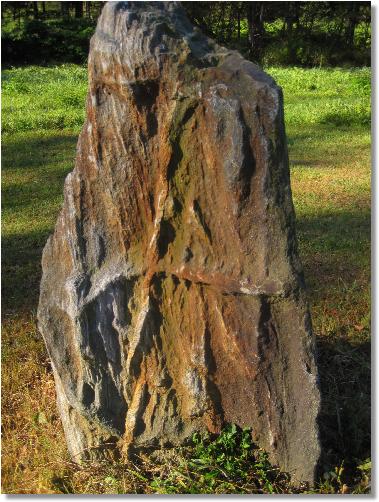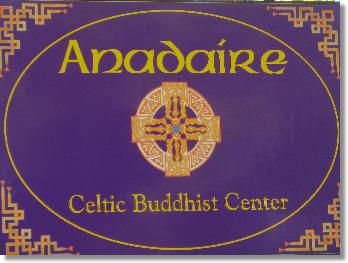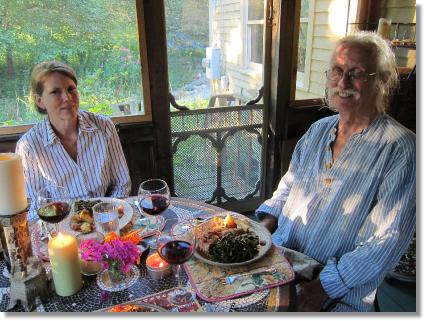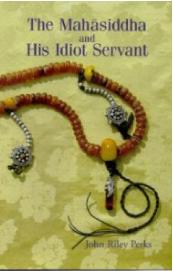What is Celtic Buddhism?
Posted 31-August: 2012
by Bill Scheffel

Stone. Saxton's River, Vermont.
In September of 2010, I visited John Perks, an old friend and founder of Celtic Buddhism, and his wife Julia on the land they own in Saxton's River, Vermont. (see my blog An Open, Exploratory Adventure With No Conclusions for an account of the trip). In August, I visited John and Julia again, and over dinner John asked me, "What is Celtic Buddhism?" Over the past two years I'd half unconsciously reflected on the question and in that moment a series of responses, a kind of list, came to my mind and out my mouth. The next day, John asked me if I would write the list down - which eventually became this essay:
What is Celtic Buddhism?
Celtic Buddhism "pre-exists" in iconography, such as the Celtic cross and knot. These symbols are immediately recognizable in The West, in a similar way Egyptian symbols are, but for many more familier culturally and closer to us in time. This iconography is similar to the entire canon of Western design motifs, the acanthus and rosettes that decorate everything from tablecloths to architectural columns. Celtic iconography calls to us with geometric precisian and depth, it calls to us archetypically. One answer to the question, What is Celtic Buddism might be that it is a design within our own mind, or a design that is mind.
I feel there is a certain softness to the dralas or spirits of the Celtic tradition. This must be the softness of moisture, of grass that stays green twelve months of the year, of moss, lichen and peat. On a planet that is speeding up and heating up, the softness of these dralas call to us like a cosmic first-aid station or oasis. Leprechauns, fairies, dralas; I've not been to Ireland but John Perks tells me the country is thick with them. Thick with an atmosphere of softness, which can perhaps be invoked wherever we are just by feeling it. Celtic Buddhism is Buddhist in the way Buddhism has always been; that is, as Buddhism migrated from India to China, Tibet, Korea (and now places like Canada, Brazil and Mexico) it has always taken up with the local spirits, who became in turn protectors and other agents of awake.
The indigenous traditions of the Celts survived far better than others; institutional Christianity waged hundreds of years of war upon these "pagan" traditions; some where lost entirely, some went hidden and underground, as the Alchemists and Gnostics did. Chögyam Trungpa was deeply saddened by the loss of the great drala traditions of Europe and his own mind-stream transmitted to us a ground in which we can fill in the path and fruition. It is always our own inquiry and willingness to investigate that actives the ground, path and fruition of the spiritual path.
The mind-that-follows-tradition becomes periodically dogmatic and overcome with its own rules, at odds with the inquiring-mind seeking to take the lid off the box of mysteries; these minds exist in all of us, exist throughout all time. Which is to say the tradition-upholding inquiring essence of Christianity - Christianity at its humanistic best - was frequently preserved or given new life in Ireland and other places of Celtic culture. The traditional cum way-seeking hearts of Christian monks and Druid priests mixed and influenced each other and produced saints and other interesting folk galore. Historical evidence increasingly suggests it is not too far fetched to think that Emperor Ashoka's Buddhist inspired edicts reached as far as Ireland, since Celtic culture spanned the Roman Republic/Empire. And since Buddhist monasteries have been found in Hellenistic Greece, it is now possible to think of Buddhism, Celtic paganism and Christianity as all being part of the same awakened gene-pool - Celtic Buddhism for short.
All these reflections are marginal - which gives another definition for Celtic Buddhism to perch upon. Marginal means "situated on the edge or margin of something." Seonaidh (pronounced SHOW Nee; Celtic for "John") Perks founded Celtic Buddhism according to the inspiration/instructions he received from Chögyam Trungpa. Celtic Buddhism has "lineage holders" but is it a "lineage"? I think it is a congregation of people who have gathered around the same accident or occurrence. What Seonaidh put into words has become this eclectic gathering, certainly "marginal" in comparison to the organizations Chögyam Trungpa founded, but also comprised - from what I hear (or know about myself) - of people on the margins. People who work with marginal populations, for instance, or by eccentricity are called marginal by others. As word, marginal is close in meaning to liminal, which means "occupying a position at, or on both sides of, a boundary or threshold" (a definition that works very well, it seems, for drala).
I recently heard an American Sufi teacher lead an evening of meditation. He had a beautiful grasp and articulation of shamatha and vipashyana - or "calm abiding" and 'insight" - the foundations of meditation within nearly all schools of Buddhist tradition. It helped me once again recognize that if one meditates with diligence, one can't not experience these principles, provided one is allowing the basic principle of meditation to occur (resting the mind and became aware). Of course extremes occur - too tight, trying to control it all or manufacture highs; or too loose, just making is all up - but within this broad field of meditation there is plenty of room to encounter intersections of, say, Buddhism and Celtic wisdom. To pararphase the French Poet Francis Ponge, but in this sense regarding meditation: Not only has all not been said, but almost everything remains to be said. I think this is particularly true from point of view of nowness; that each era, generation, time - even moment - must find new or fresh ways of articulating tradition and its methods. Celtic Buddhism is an example of one such articulation.


Julia and Seonaidh Perks, August 2012.
On The Teacher, by Seonaidh Perks: With the teacher, whoever is your teacher, in Celtic Buddhism we say Anam Cara. It's a Celtic term that means "soul mate" actually, so that the relationship between you and your teacher is a similar aspect, it's one of being soulmates. We'll talk about the Anam Cara system possibly in our next talk. In any case, when that transmission occurs maybe nothing special happens for a while. Then, because of one's whole openness and sensitivity towards another being, one's teacher, then even after that teacher is no longer physically present, still the relationship is there and is still continuing. So that lineage is very much like that.

